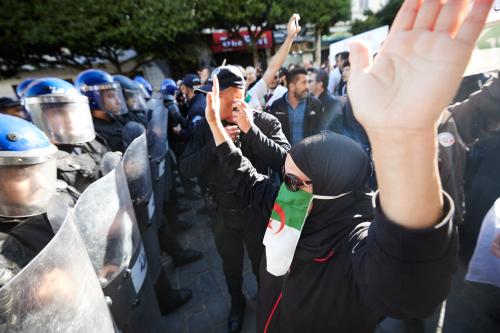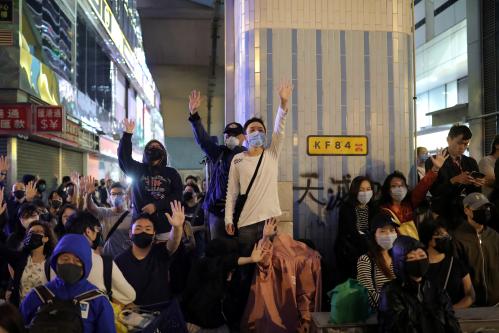Mass protests have become a common phenomenon. In 2019, they occurred in nearly every corner of the globe and in economies of all kinds—developed and developing, democracies and autocracies, places with high and low inequality, resource-rich and -poor. The incidence of strikes and demonstrations spiked in 2011—the year of the Arab Spring—and has stayed elevated since then (Figure 1). More recently protests spread to Latin America, Hong Kong, and Middle Eastern countries, including Algeria, Lebanon, Iraq, and Iran, which were relatively unaffected by the Arab Spring events. What is going on? Has the world entered a period of perpetual social unrest?
Figure 1. The number of demonstrations and armed conflicts between 1995 and 2015
Sources: Witte, Burger and Ianchovichina (2020) “Subjective Well-being and Peaceful Uprisings” Kyklos 73: 120-158 using CNTS (2015) for the number of demonstrations and Pettersson & Wallensteen (2015) for the number of armed conflicts.
It is easy to miss the big picture if one simply looks at the triggers of protests, which differ considerably across countries. In many cases, protests have been sparked by austerity measures such as increases in the prices of public services, cuts in public sector employment, reforms reducing or eliminating entitlement benefits, or fuel and food price hikes. In other cases, triggers have been political, many of them linked to instances of election fraud or power struggles during periods of political transition, events exposing abuse of power by authorities, or the passing of laws and regulations that either limit citizens’ rights or discriminate against certain groups. Protests have also occurred following incidents revealing social injustice or corruption.
These triggers may serve as sparks for the unrest, but they tell us little about the fuel and the conditions needed to spread and sustain the fire. Several theories can help us think about the grievances that fuel protests and the context that determines the extent to which people can voice these grievances in an organized way (Figure 2). Two of the dominant theories emphasize the importance of grievances. The first one—known since antiquity—tells us that high and rising economic inequality is toxic to social cohesion and harmful to political stability. The second one tells us that grievances linked to feelings of relative deprivation—defined as the gap between expectations and achievement—increase the likelihood of popular uprisings.
Other theories focus on the context, which determines whether people can in fact organize and rebel against those in power (Figure 2). Without resources and skills, it is impossible to mobilize mass participation in nonviolent protests. Proponents of the resource-mobilization theory point out that (online) social networks have made it much easier to organize large protests as well as to spread unrest through contagion. Countries that are unable to suppress mobilization are especially likely to experience social unrest, according to the political-opportunity theory. As countries become more developed and urbanized and their citizens more educated and affluent, people’s values change and they start placing greater emphasis on political participation and civil rights. Economic development therefore can also increase the probability of protests, according to the modernization theory.
Figure 2. Root causes of peaceful uprisings: A guiding framework
Source: Modified from Witte, Burger and Ianchovichina (2020) “Subjective Well-being and Peaceful Uprisings” Kyklos 73: 120-158.
These theories are not new. Yet, surprisingly little is known about their empirical validity. The inequality and grievance-based theories have been tested in the context of armed uprisings and civil wars, not peaceful protests. Erica Chenoweth and Jay Ulfelder provide the first systematic examination of the structural theories for peaceful uprising and show that neither grievance-based models, nor models based on other explanations, including modernization, resource-mobilization, and political-opportunity theories, provide reliable predictions of nonviolent uprisings.
In a recent paper we tackle this issue again. Unlike Chenoweth and Ulfelder, in addition to objective data, we use subjective well-being indicators to adequately capture popular grievances. We also propose a new framework to empirically test the theories of social unrest (Figure 2) in which we focus on grievances while also controlling for and testing the importance of political opportunity, resource mobilization, and modernization contexts.
Using data for 118 countries from 2007 to 2014, we find that the incidence of peaceful protests and strikes tends to rise during growth slowdowns and recessions as well as during times of decreased subjective well-being, manifested in an increased incidence of suffering (Figure 3), and largely reflecting deteriorating living conditions and a decrease in the perceived ability of people to lead a purposeful and meaningful life. Increase in oil rents also tends to be associated with heightened risk of nonviolent uprisings, presumably because the increased rents widen the gap between aspirations and achievement. We do not find any evidence that increased suffering raises the probability of a civil war—a result suggesting plausibly that grievances are a necessary but not sufficient condition for armed conflict. The effect of suffering on peaceful uprisings depends neither on the country’s stage of development, nor on the political opportunities for rebellion and the ease of resource mobilization. This lack of evidence for the role of context for the relationship between grievances and uprisings might be the result of data limitations, but it could also imply that the effect of a decrease in subjective well-being on nonviolent conflict is relatively universal.
Figure 3. Correlates of peaceful protests
Sources: Witte, Burger and Ianchovichina (2020) “Subjective Well-being and Peaceful Uprisings” Kyklos 73: 120-158. Note: Darkest shade identifies significance at 1% level, medium shade – significance at 5%, and palest shade – significance at 10%, white – no significance.
While our research shows that the role of suffering is universal, grievances are often country-specific. In the case of the Middle East and North Africa, Shanta Devarajan and Elena Ianchovichina show that grievances related to a broken social contract, not high or rising inequality, led to the Arab Spring. Despite moderate income inequality measures, subjective well-being in the Arab world was relatively low and falling sharply, especially for the middle class, and in the countries where the uprisings were most intense. Research by Efstratia Arampatzi and others identifies these grievances as dissatisfaction with the standard of living, poor labor market conditions, and corruption in the form of nepotism and cronyism.
The Brookings Institution is committed to quality, independence, and impact.
We are supported by a diverse array of funders. In line with our values and policies, each Brookings publication represents the sole views of its author(s).










Commentary
Why are people protesting?
January 29, 2020